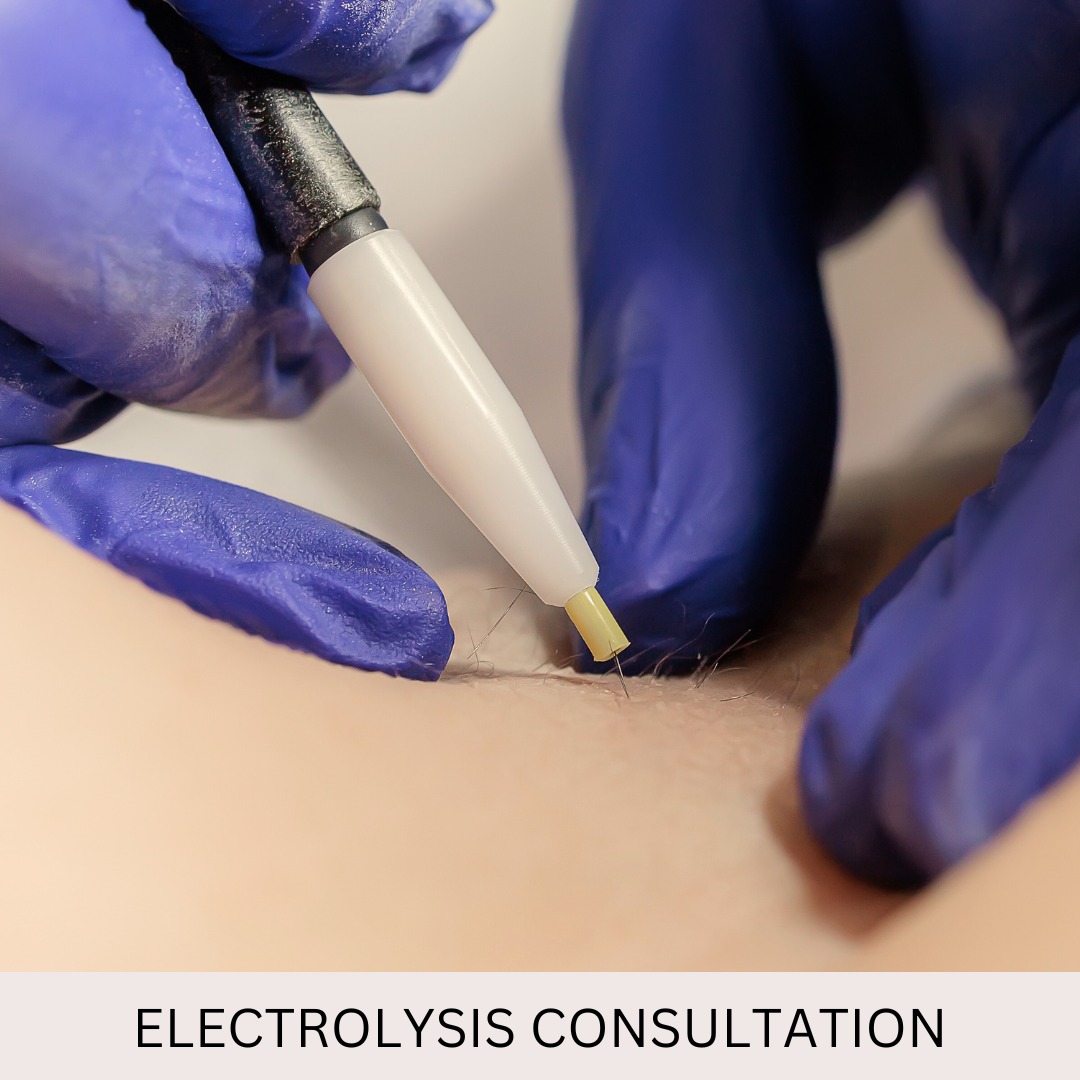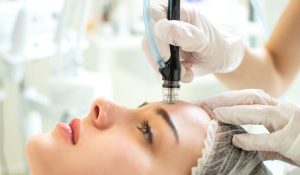Contraindications
Medication
Pregnancy or planning
Cycles of Hair growth in relation to electrolysis
Treatments need at least 2 weeks healing between sessions
Number of sessions varies, usually at least 1 to 2 years or more depending on hair growth
Maintenance sessions may be required thereafter
Remove jewellery and avoid using your phone during the session
What does electrolysis feel like?
Possible risks and side effects: hyperpigmentation, hypopigmentation, oedema, redness, swelling, possible infection.
Risks can be minimised with proper care of the skin.
Aftercare for Electrolysis
Avoid, for first 3 days: gym, beach, pools, sauna
Wear spf 30 or more, reapply when outdoors for more than 2 hours
Apply Exel Moisturising Lotion as aftercare product to assist with healing and cooling the skin
Icepacks can help reduce heat, make sure not to apply directly to the skin.
Pretreatment care
Avoid plucking, waxing or laser when undergoing electrolysis.
Hair can be shaved or bleached between sessions. Allow at least 1mm length of growth for the session.
Keep well hydrated before your session for best results.
Avoid electrolysis during period as it may be more uncomfortable
Electrolysis Hair Removal: Frequently Asked Questions (FAQ)
Electrolysis is a permanent hair removal method that many people turn to for smooth, hair-free skin. If you’re considering electrolysis, you likely have some questions about how it works, what to expect, and how to care for your skin before and after the procedure. Below are some common questions and answers to help you better understand this treatment.
1. What is Electrolysis Hair Removal?
Electrolysis is a hair removal technique that uses an electric current to destroy hair follicles. Unlike temporary methods like shaving or waxing, electrolysis permanently removes hair and can be used on almost any area of the body.
Electrolysis requires multiple sessions to achieve permanent results and is not an instant solution.
2. What are the Contraindications for Electrolysis?
Certain medical conditions or factors may make electrolysis unsuitable for some individuals. These include:
- Medication: Certain medications, such as those that affect skin sensitivity or healing, can interfere with electrolysis. Consult with your technician if you’re on medication.
- Pregnancy or Planning: If you’re pregnant or planning to become pregnant, it is best to avoid electrolysis during this time.
3. How Does Hair Growth Cycle Affect Electrolysis?
Hair growth occurs in cycles, which consist of three distinct phases: anagen (active growth), catagen (transition), and telogen (resting). Electrolysis is only effective when hair is in the anagen phase, as the follicle is fully attached to the root, allowing the electrical current to target and destroy the entire follicle.
However, not all hair on the body is in the anagen phase at the same time. Different follicles transition through the growth cycles at varying rates. This means that during any given electrolysis session, only a portion of the hairs in the treated area will be in the active growth phase.
To ensure that all hair follicles are treated during their optimal phase, multiple sessions are required. The exact number of treatments varies depending on factors like the area being treated, hair density, and individual hair growth patterns, but it can take upwards of 1 to 2 years of consistent sessions to achieve permanent hair removal, depending on the amount of hair to be treated.
4. How Long Between Sessions Should I Wait?
You will need to allow at least two weeks of healing between electrolysis sessions. This gives your skin time to recover and for the treated hair to cycle through the growth phases before your next treatment.
5. How Many Electrolysis Sessions Will I Need?
The number of sessions varies depending on the individual, the area being treated, and the thickness of the hair. In most cases, electrolysis requires at least 1 to 2 years of consistent sessions, with maintenance sessions possibly needed afterward.
6. Do I Need Maintenance Sessions?
Yes, maintenance sessions may be required even after you’ve completed your initial series of electrolysis treatments. The frequency of these sessions will depend on how your body produces new hair growth.
7. What Should I Avoid During My Electrolysis Session?
- Jewellery: Remove all jewellery to avoid interference with the electric current.
- Phone: It’s recommended to avoid using your phone during the session.
8. What Does Electrolysis Feel Like?
Electrolysis can cause a mild to moderate discomfort, often described as a tingling or stinging sensation. Pain tolerance varies, but many compare it to the sensation of a rubber band snapping against the skin. You also have the option of applying numbing cream before your session. It is suggested to cover the layer of cream on your skin with plastic wrap depending on manufacturer’s instructions.
9. What Are the Possible Risks and Side Effects?
As with any cosmetic procedure, there are some potential risks:
- Hyperpigmentation (darkening of the skin)
Electrolysis can potentially cause post-inflammatory hyperpigmentation (PIH), particularly in individuals who are prone to this condition. PIH occurs when the skin responds to inflammation by producing excess melanin, which leads to darkened patches or spots.
In electrolysis, the electric current used to destroy hair follicles generates heat, which can cause minor inflammation in the treated area. For those susceptible to PIH—particularly people with darker skin tones or those with a history of hyperpigmentation—the body’s natural response to this localised inflammation may result in darker pigmentation forming in the treated areas after the session.
While post-inflammatory hyperpigmentation is not a permanent condition, it can take weeks or even months to fade, depending on the individual’s skin type and how well they care for their skin post-treatment.
To minimize the risk of PIH, it’s important to follow proper aftercare:
- Sun protection: Regular use of SPF 30 or higher is crucial. Exposure to UV rays can exacerbate hyperpigmentation, making it more persistent.
- Cooling and soothing the skin: Using ice packs (with a cloth to avoid direct contact) and soothing lotions like Exel Moisturising Lotion can reduce inflammation and calm the skin.
- Avoid picking or scratching: Irritating the treated area can worsen inflammation and increase the likelihood of PIH.
For those highly prone to hyperpigmentation, consult with your electrologist beforehand. They may recommend a patch test or alternative hair removal methods to reduce the risk.
- Hypopigmentation (lightening of the skin)
- Oedema (swelling)
- Redness and irritation
- Scabbing and bruising may occur
- Infection if aftercare guidelines are not followed
Risks can be minimised with proper pre- and post-treatment care.
10. How Should I Care for My Skin After Electrolysis?
For the first three days after treatment, it’s important to avoid:
- The gym (sweating can irritate the skin)
- Beach, pools, and saunas (chlorine, saltwater, and heat can slow healing)
Use the following aftercare methods:
- SPF 30+ sunscreen: Always wear sunscreen after treatment and reapply if you’ll be outdoors for more than 2 hours.
- Exel Moisturising Lotion: Apply this to keep your skin moisturised and help with healing.
- Ice packs: If you experience heat or swelling, ice packs can help, but never apply them directly to the skin.
- Avoid picking at any scabs that may be present to avoid disrupting healing or possible scarring.
11. What Are Some Pretreatment Tips for Electrolysis?
To ensure you get the best results from your electrolysis session, follow these guidelines:
- Avoid plucking, waxing, or laser treatments while undergoing electrolysis, as they disrupt the hair follicle.
- Shaving or bleaching is allowed between sessions, but allow at least 1mm of hair growth for the session.
- Stay hydrated before your session, as hydrated skin tends to respond better to treatment.
- Avoid electrolysis during your period, as it may be more uncomfortable during this time due to increased sensitivity.
Electrolysis can be a life-changing treatment for those seeking permanent hair removal. By following the recommended pre- and post-treatment care, you can minimize risks and ensure the best possible outcome. Always consult with your technician about your specific needs and any concerns you may have.



